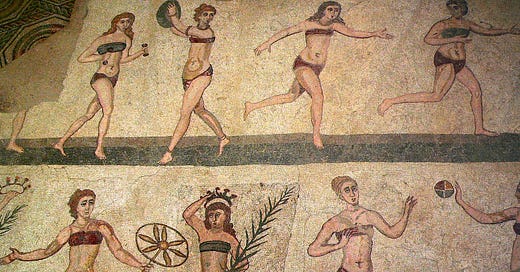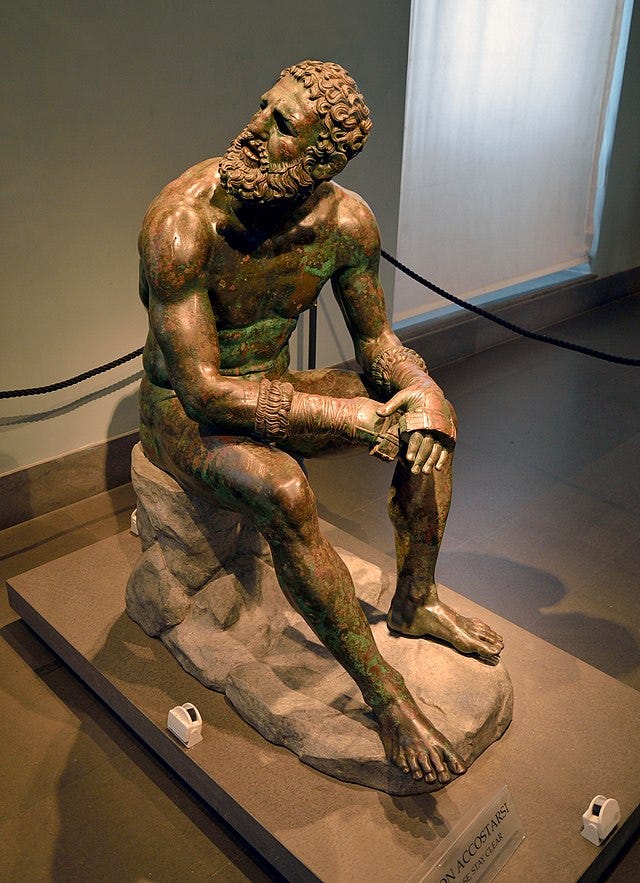
The two-piece swimsuit was forever cemented in American pop culture history with Brian Hyland’s 1960 hit, “Itsy Bitsy Teenie Weenie Yellow Polka Dot Bikini.” You remember the chorus. “It was an itsy, bitsy, teenie, weenie, yellow, polka dot bikini, that she wore for the first time today.” The tune was written by the Four Seasons’ own Bob Gaudio. And whether you like it or not, after you hear the song once, you can never unhear it. With the release of that popular tune, the controversial, midriff-bearing beachwear reached a fever pitch in America.
Going Nuclear
But years before that, in July 1946, French fashion designer Louis Réard first unveiled a daring new women’s clothing item that didn’t leave much to the imagination. As model Micheline Bernardini showed off his shocking invention at a bustling Parisian pool, the world was gifted the “bikini.” Réard named it after the U.S. nuclear testing site at the remote Pacific island of Bikini Atoll. Anyone who’s ever watched an episode of the kids’ show SpongeBob SquarePants may have taken note of the characters’ seemingly radioactive traits. SpongeBob, the show’s benevolent hero, lives in Bikini Bottom. Many, including myself, have speculated over the years the show’s producers and writers weaved in quite a bit of American (and a bit of French) history into the storylines.
Once Réard introduced his innovative “bikini” in 1946, it became a summer staple. Girls dreamed of finding the perfect bikini to show off at the beach. Fathers prayed they never did.
Like the exploding bombs of the Bikini Atoll nuclear testing site, the sexy swimwear exploded onto the fashion scene, and its fallout could be registered on a global scale.
But did Réard truly invent the “bikini?” Or was he the one to simply coin the creative name?
The Room of The Ten Girls
A popular tourist site located on the outskirts of the Sicilian community of Piazza Armerina displays one of historic Rome’s most treasured mosaic attractions. The Villa Romana del Casale houses many ancient mosaic pieces, but one in particular continues to draw crowds, even though it was first constructed in the early years of the fourth century A.D.
Located in a secluded area known as “The Room of The Ten Girls,” the large mosaic features several women engaging in what appears to be a variety of sports. Their clothing of choice? Their own version of the modern bikini.
While contemporary women generally purchase two-pieces for sunbathing, ancient women of cultures like Rome wore them for athletic purposes. As depicted in the pictures, these women played volleyball, ran competitively, and utilized weights to increase their long jumps and other functional athletic movements.
Now nicknamed the “bikini girls,” their own two-pieces generally featured a rather form-fitting fit for functional purposes. While many of today’s bikinis are known as “string bikinis” due to their ties and decorative tassels, ancient Roman women preferred to keep things simple, with a straightforward bottom and bandeau style top.
While ancient male athletes often trained in their birthday suits (the cool kids mean “in the nude” when they use this term), or with minimal protection around their sensitive areas, it was customary for ancient female athletes to cover up a bit more.
While the female depiction of athleticism on the mosaic communicates a fun, healthy, competitive environment, male athleticism is a different story. The film “Gladiator” takes viewers on a particularly excruciating journey featuring these ancient professional fighters. But one of the more reality-based examples of ancient male athleticism I’m particularly taken by is the bronze statue titled, “Boxer At Rest.” From his beat up hands to the emotive expression on his face, one realizes while staring at this beautiful art piece just how rugged these men had to be.
Fashion As Part of Culture
As bikinis make their yearly comeback due to warm weather and the impending July 4th holiday, I took a moment to reflect on just how long this fashion item has been around. It is amazing how a (tiny) piece of clothing can tell us so much about the lives of women in cultures both ancient and modern.

Did Louis Réard take a trip to that quaint Sicilian town and stumble upon The Room of The Ten Girls only to be taken aback with intense artistic inspiration?
Unlike the enduring, beloved bikini, the answer to that question and so many more remain a mystery, and therefore leave much to the imagination.
Sources:
https://www.history.com/this-day-in-history/bikini-introduced
https://www.ancientworldmagazine.com/articles/roman-girls-bikinis-mosaic-villa-romana-del-casale-sicily/
https://wwd.com/feature/history-of-the-bikini-1235647398/






Must have something on your mind, maybe like maing sure your bod is ready for that yellow polka-dot one of yore this summer?
Ancient bikinis... who knew? (Not me!)